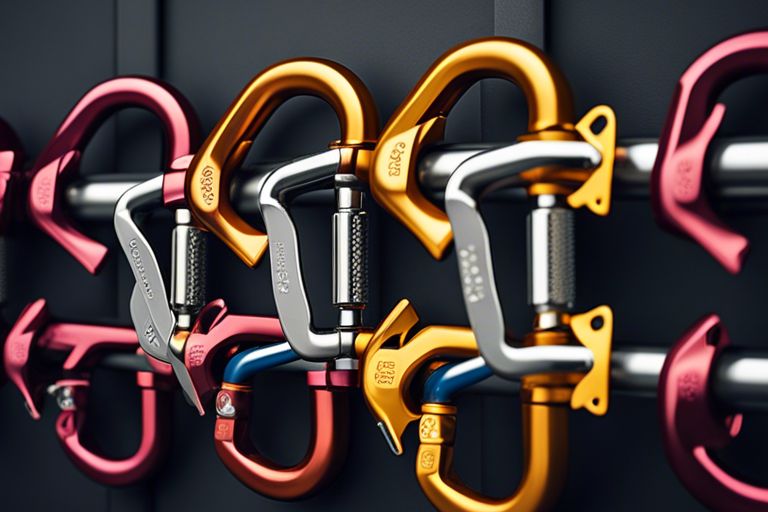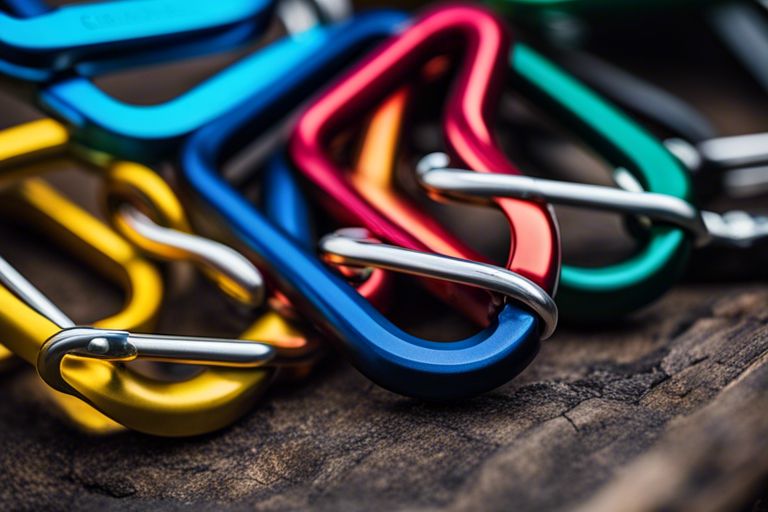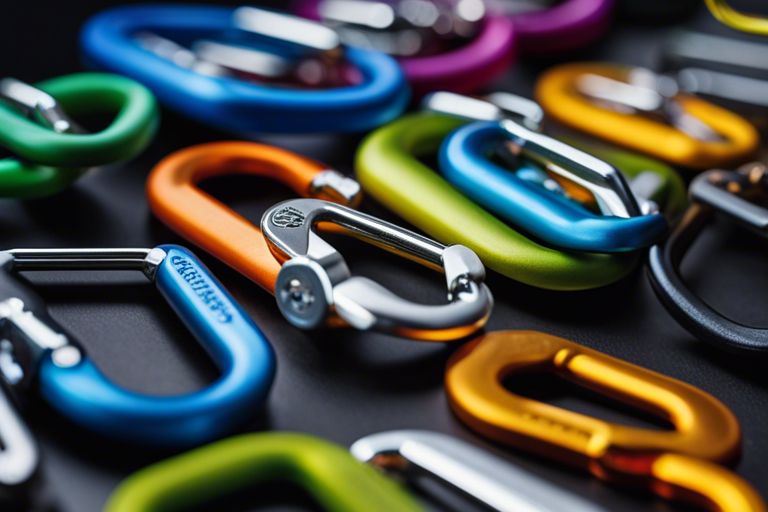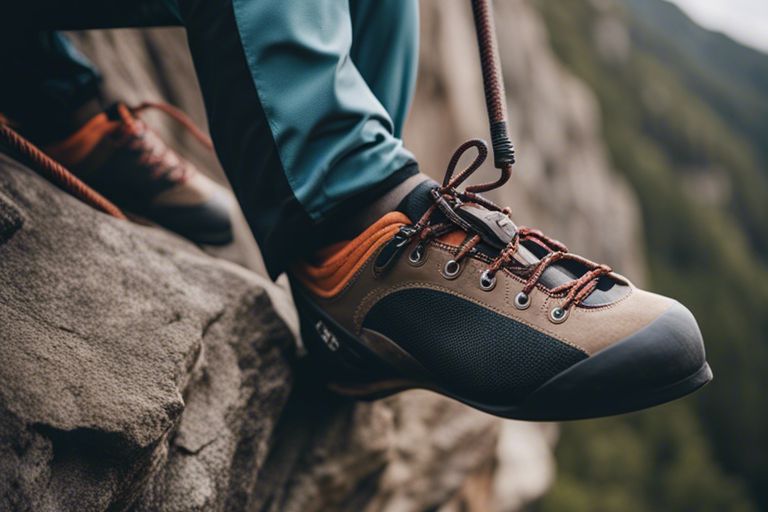#Strength is a vital aspect of climbing gear, and understanding how carabiners are rated can enhance your safety and performance. In this informative guide, you will explore the intricate grading system that determines a carabiner’s strength, functionality, and best use cases. With your knowledge of these ratings, you can make informed decisions when selecting carabiners for your adventures, ensuring that they meet your specific needs and safety requirements. Let us investigate into the fascinating world of carabiner ratings and empower your climbing experience!

Key Takeaways:
- Load Ratings: Carabiners are rated based on their maximum load capacity, typically measured in kilonewtons (kN), which indicates how much weight they can safely bear.
- Types of Ratings: There are different ratings for carabiners, including the major axis, minor axis, and gate open ratings, which highlight their strength in various conditions.
- Quality and Safety: Carabiners made from materials like aluminum or steel and adhering to standards such as those set by the UIAA or CE are considered more reliable and safe for climbing or other heavy-duty uses.

The Basics of Carabiner Ratings
While engaging in your adventurous pursuits, it’s crucial to understand the subtle yet significant aspects of the tools you employ. Carabiner ratings are designed to convey the strength and safety features of these important climbing accessories. A carabiner’s rating informs you about the maximum load it can hold without risk of failure. Typically, you will find these ratings stamped directly on the spine of the carabiner, denoting its strength in kns, and often categorized by different orientations such as major axis, minor axis, and with the gate open.
What are Carabiner Ratings?
One cannot underestimate the elegance of simplicity that carabiner ratings provide. These ratings follow international standards defined by organizations such as the UIAA (International Climbing and Mountaineering Federation) and the CE (European Conformity). They indicate the amount of force the carabiner can withstand before it might break, thus providing you with critical information as you plan your climbing or hiking expeditions. An understanding of these ratings helps you select the right carabiner for your specific activity, ensuring your safety and performance are paramount.
Why are Carabiner Ratings Important?
Ratings play a pivotal role in ensuring the safety and efficacy of your climbing gear. With each use, you depend on carabiners to hold your weight and keep you secure. Understanding the ratings allows you to make informed choices, ensuring that the equipment you select aligns with the type and intensity of your activities. Whether you are clipping into a rope during an ascent or organizing gear on your harness, knowing the limits and capabilities of your gear is important.
Carabiner ratings are not merely numbers; they embody the promise of safety. By adhering to these ratings, you are empowered to venture into challenging terrains and reach new heights, all while minimizing the risk of gear failure. Familiarizing yourself with these ratings enhances your overall experience and ensures that your connection to the vertical world remains secure and dependable.

The Rating Systems
You may find it intriguing how carabiners, crucial tools in climbing and outdoor activities, are evaluated for safety and performance. Understanding rating systems is crucial as they provide a guide to the strength and reliability of these devices, ensuring your climbing experience is secure. Several organizations have established standards to rate carabiners, the most notable being the UIAA, CE, and ANSI. Each of these systems uses rigorous testing to assess and label the strength of carabiners, allowing you to select the right gear for your adventures.
UIAA (Union of International Alpine Associations) Ratings
Systems of rating established by the UIAA are well-respected within the climbing community. This organization sets a rigorous standard, requiring carabiners to withstand a significant force — typically around 20 kilonewtons (kN), which equates to about 4,500 pounds of force. Carabiners that meet or exceed this threshold are marked with the UIAA insignia, indicating they are reliable enough for alpine climbing and other demanding environments. The testing is not limited to static pull; it also includes dynamic loads to simulate real-life scenarios, ensuring that each carabiner can perform under various conditions.
CE (Conformité Européene) Ratings
Conformit standards are often synonymous with quality and safety in European Union countries. Carabiners bearing the CE mark have undergone rigorous testing, particularly the EN 12275 standard, which dictates specific requirements for climbing hardware. For a carabiner to earn this certification, it must endure and recover from various forms of stress, including both dynamic and static loads, ensuring it is capable of maintaining structural integrity under pressure.
International standards define the strength requirements for carabiners with CE ratings, which typically indicate that the device can handle a minimum of 20 kN in a major axis pull. This caters to climbers’ needs for both safety and reliability, ensuring that each carabiner can withstand significant forces typically encountered during climbing activities. The clear indication provided by the CE mark assists you in confidently choosing gear that has been rigorously evaluated for performance.
ANSI (American National Standards Institute) Ratings
For those within the American climbing community, ANSI ratings provide another meaningful benchmark for evaluating carabiner durability. The ANSI standards emphasize equipment performance through extensive testing methods, which assess the strengths of carabiners across various dimensions, including major and minor axes, as well as gate open positions. Carabiners that meet ANSI approval standards are designed to ensure user safety through both controlled laboratory conditions and real-world applications.
Plus, ANSI ratings often intersect with recreational uses beyond climbing, extending into general outdoor activities. This adaptability makes it crucial for you to pay attention to whether your chosen carabiners are ANSI rated, as it confirms their suitability for a range of activities, be it climbing, canyoneering, or other outdoor endeavors. By taking the time to understand these rating systems, you empower yourself to make informed choices that prioritize safety in your adventures.
Factors Affecting Carabiner Ratings
Not all carabiners are created equal. Their ratings are influenced by a variety of factors that determine how safely they can be used in climbing, camping, and other outdoor activities. Understanding these factors is critical for ensuring your safety while engaging in adventurous pursuits. Here are some of the main influences on carabiner ratings:
- Material Strength
- Gate Closure Strength
- Minor Axis Strength
- Gate Open Strength
Assume that you are selecting a carabiner for your next climbing expedition. Knowing how these factors interplay can significantly enhance your outdoor experience.
Material Strength
One of the most pivotal factors affecting a carabiner’s rating is its material strength. Typically, carabiners are made from aluminum or steel, both of which have unique properties that affect their reliability. Aluminum carabiners are lightweight and corrosion-resistant, making them popular among climbers, while steel carabiners, although heavier, offer superior strength and durability for heavier loads. The choice of material directly correlates to the weight-bearing capacity, longevity, and overall performance of the carabiner.
Additionally, the manufacturing process plays a role in the material’s overall strength. Different heat treatments and alloy compositions can result in variations that affect both usability and safety. Therefore, always consider the type of material and its durability when choosing a carabiner for your specific needs.
Gate Closure Strength
Factors affecting gate closure strength are crucial for carabiner functionality. The gate mechanism must reliably close under stress to ensure that your gear does not accidentally disengage. This component is tested to determine how much force it can withstand before it opens unintentionally. A key aspect of this is the design of the gate itself—whether it’s a straight, bent, or locking mechanism, the specifics contribute significantly to its closure strength.
Carabiner gate closure strength is particularly important when it comes to dynamic loads. If the carabiner experiences sudden jolts or impacts, the gate must remain closed to prevent accidents. Be mindful of the operational conditions, as temperature and wear can affect gate strength over time. Regular inspection and maintenance can help preserve this vital aspect of your gear.
Minor Axis Strength
Material design further impacts the minor axis strength of a carabiner, which refers to its strength when force is applied perpendicular to the main spine. Unlike the major axis, which experiences load along the length, the minor axis can be more susceptible to failure as it is often less robust. For instance, if you were to use your carabiner to connect two points across a minor axis, you need to be acutely aware of the potential weaknesses and avoid applying excessive loads in this direction.
Axis strength must not be overlooked, as it is critical for avoiding serious accidents during climbs or when securing equipment. Always opt for carabiners that offer a higher minor axis rating, especially if your activities involve dynamic movements or swings where unanticipated forces may be exerted on the gear.
Gate Open Strength
The gate open strength is yet another vital aspect that ensures your carabiner performs under pressure. This strength rating assesses how much force the carabiner can handle before the gate opens unexpectedly. Essentially, this provides a measure of security against accidental openings during challenging maneuvers or sudden movements, critical factors in high-stakes environments.
Minor changes in manufacturing or wear from frequent use can affect the gate open strength of your device. Always inspect your gear carefully, especially if you notice any signs of wear or damage. Selecting carabiners with higher gate open strength ratings gives you peace of mind when engaging in climbing or other activities where safety is paramount.
Types of Carabiners and Their Ratings
Despite the variety of carabiners available, understanding their ratings is important for ensuring safety and functionality in your climbing endeavors. Various types of carabiners are tailored to specific applications and activities, each with its unique rating system. Below is a table that outlines five common types of carabiners along with their typical ratings:
| Type of Carabiner | Typical Ratings (kN) |
|---|---|
| Oval Carabiners | 23 kN |
| D-Shaped Carabiners | 25 kN |
| HMS Carabiners | 25 kN |
| Wiregate Carabiners | 20 kN |
| Locking Carabiners | 25 kN |
Perceiving the nuances of each type enhances your ability to choose the right carabiner for your climbing or outdoor needs. Let’s take a closer look at some of the most common types of carabiners and explore deeper into their specific features and ratings.
Oval Carabiners
Oval carabiners are characterized by their symmetrical oval shape, which allows for even weight distribution. This balance makes them ideal for belaying and rappelling, as they reduce the chances of cross-loading. The design also facilitates easy clipping and unclipping, particularly useful for quickdraws and organizing gear.
With a typical strength rating of around 23 kN, oval carabiners are versatile tools that blend well with many climbing applications. Their unique shape offers a greater amount of usable space for setting up systems, making them a favorite among climbers who prioritize stability and reliability.
D-Shaped Carabiners
An excellent choice for a variety of climbing and camping scenarios, D-shaped carabiners are slightly more asymmetrical than their oval counterparts. This shape allows them to manage weight and forces more efficiently, making them particularly strong and reliable when used in critical situations such as lead climbing.
With a typical strength rating of approximately 25 kN, D-shaped carabiners are often the go-to option for climbers looking for strength and durability. Their design minimizes the risk of cross-loading, providing an added layer of safety during your outdoor adventures.
Carabiners in the D-shape classification excel in their ability to securely attach climbing gear and tools. Known for their efficient strength-to-weight ratio, they are particularly effective when used in rescue or anchor systems, thus enhancing your overall safety during climbs.
HMS Carabiners
To cater to belaying and rappelling needs, HMS carabiners are designed with a wider body that accommodates various knots and belay devices. They are also equipped with a screw lock or automatic locking mechanism for added security, making them a reliable choice for climbers who often switch between different climbing methods.
Typically rated at around 25 kN, HMS carabiners are ideal for handling dynamic loads during climbing activities. Their shape allows for smooth clipping and unclipping, making it easier for you to manage gear while keeping safety at the forefront.
With their distinct configuration, HMS carabiners allow for enhanced maneuverability and ease of use in complex setups or when managing multiple ropes. They stand out as indispensable tools that not only provide security but also improve efficiency in your climbing practices.
Wiregate Carabiners
Carabiners designed with a wiregate mechanism offer an alternative to traditional locking methods. The wiregate design minimizes the overall weight without sacrificing strength, which is incredibly beneficial during extended climbs when every ounce counts. Their unique construction also reduces the chance of gate whiplash, improving reliability.
These carabiners usually carry a rating of around 20 kN, making them suitable for various climbing applications, including sport climbing and trad climbing. They also excel in situations where quick access is important, such as when connecting gear or attaching to anchors.
Carabiners with a wiregate design are favored for how effortlessly they can be clipped and unclipped, often allowing you to streamline your gear management. With their lightweight and efficient ratings, they serve as an excellent choice, especially for climbers focused on optimizing their climbing kit.
How Carabiners are Tested
Once again, understanding the intricate world of carabiners involves delving into the testing methods that ensure their safety and reliability. These robust devices, important for climbers and outdoor enthusiasts alike, are subjected to rigorous evaluations. By familiarizing yourself with these testing processes, you can appreciate the engineering behind your gear and the standards it must meet.
Static Testing
For static testing, carabiners endure a weight applied steadily and without any sudden movements. The assessment ensures that each carabiner can withstand a specified maximum load without deformation or failure. It simulates the steady load conditions that equipment experiences during activities such as belaying or securing a climbing rope. The strength rating of a carabiner is usually given in kilonewtons (kN), and static testing helps determine if the carabiner can handle that rating safely.
During this method, carabiners are typically pulled in their major axis—the direction they are primarily designed to bear weight. If a carabiner fails during this test, engineers take note of the load at the moment of failure, allowing them to adjust the design if necessary, ensuring that your chosen gear meets safety standards.
Dynamic Testing
The dynamic testing of carabiners simulates the forces experienced during activities like a fall. In this procedure, a weight is dropped from a certain height to assess how well the carabiner absorbs and distributes the impact force. This is crucial because a climber’s weight can increase dramatically upon a sudden stop, and it is important that the equipment can endure these dynamic loads without breaking.
During dynamic testing, the carabiner is subjected to forces much greater than its static rating. The results inform you about the carabiner’s ability to withstand the shock from falls, which is vital for safety in climbing situations. The rigors of dynamic testing ensure that your carabiner will perform as expected when it matters most, acting as a reliable lifeline in precarious situations.
To appreciate the importance of dynamic testing, consider that the forces involved in climbing can be unpredictable and intense. Thus, carabiners undergo this comprehensive testing to ensure that even with the sudden changes in tension, your gear can handle those stresses. This knowledge equips you with confidence when you’re scaling heights.
Environmental Testing
Any outdoor adventure entails exposure to a variety of environmental factors, and carabiners are no exception. Environmental testing assesses how well these devices can endure elements such as moisture, extreme temperatures, and UV exposure. This process is important for ensuring that your carabiner remains functional and reliable despite the inevitable wear and tear from prolonged use in adverse conditions.
Furthermore, environmental testing often involves subjecting carabiners to rigorous conditions, such as saltwater immersion or prolonged UV exposure. These tests determine how well the materials withstand corrosion and degradation, ensuring that when you reach for your gear, it will not fail you in the field.
This understanding of environmental testing is vital for your selections. Each carabiner may be rated for specific conditions, and knowing this can help you choose the right one for your outdoor pursuits. By prioritizing gear that withstands the elements, you can fully embrace the beauty of nature with the peace of mind that your equipment is ready for any challenge.
Interpreting Carabiner Ratings
To fully understand how to choose the right carabiner for your outdoor adventures, it is imperative to interpret the ratings that manufacturers provide. Carabiner ratings are depicted on their labels, which provide vital information regarding their strength and application. By learning to read these labels, you can ensure that your selection corresponds to both your needs and safety requirements.
Reading the Label
Interpreting the information on a carabiner’s label begins with understanding the symbols and numbers displayed. Typically, you will notice a rating system that indicates the maximum weight the carabiner can safely hold. These ratings are often denoted in kilonewtons (kN), where one kN is equivalent to approximately 225 pounds of force. Keep an eye out for additional symbols that may signify specific use cases, such as whether the carabiner is suited for climbing, mountaineering, or general use, providing you with insight into its safety and performance standards.
Understanding the Numbers
One vital aspect of carabiner ratings that you must grasp is the importance of the numbers displayed. For instance, a rating of 20 kN equates to a breaking strength of around 4,500 pounds—an impressive figure that speaks to the carabiner’s quality. However, it’s crucial to note that this strength is often tested under specific conditions; therefore, knowing the limits is imperative. Additionally, some carabiners may have different ratings for various orientations, such as when loaded in the spine or the gate; these distinctions further influence your selection process.
Carabiner ratings often reflect specific scenarios and stress tests undertaken by manufacturers. When selecting a carabiner, it is paramount to consider how you intend to use it, be it for climbing, belaying, or rigging. Each situation may demand a different rating, thus understanding these numbers allows you to make an informed decision for your exceptional activities.
Considering the Context
On top of understanding the numbers, it’s crucial to consider the context in which you will be using your carabiner. For instance, a carabiner rated for climbing sports might not be suitable for industrial applications, despite having a high strength rating. Environmental factors such as temperature, corrosion, or wear can also impact the effectiveness of a carabiner. Recognizing how the context can affect the performance of your equipment ultimately ensures your safety and efficiency in every circumstance.
Considering the context of your activities not only informs your choice of carabiner but also helps you recognize the limitations and performance variations with different models. Always assess your surroundings and anticipated stress loads, as these factors play a crucial role in maintaining safety and functionality throughout your experiences.
Summing Up
As a reminder, understanding how carabiners are rated is vital for ensuring your safety when engaging in climbing, hiking, or other adventure sports. Carabiners are rigorously tested and rated based on their strength, which is typically expressed in kilonewtons (kN). By familiarizing yourself with the various types and their specific ratings, you equip yourself with the knowledge necessary to make informed decisions about the gear you choose to carry. Each rating indicates its suitability for different uses, from quick draws to emergency situations, so your awareness is vital for your safety and success outdoors.
In closing, remember that a higher rating doesn’t always mean a carabiner will suit every task. It’s your responsibility to select the right carabiner for your needs, considering factors like the type of climbing you’ll be doing and the forces likely to be exerted on the gear. By prioritizing the correct rating, you ensure that your adventures remain not only thrilling but also secure. So, next time you reach for a carabiner, let this understanding guide your choice, and may your outdoor experiences be both safe and exhilarating.
FAQ
Q: What does the rating on a carabiner indicate?
A: The rating on a carabiner indicates its strength and load-bearing capacity. This rating is usually expressed in kilonewtons (kN), which is a measure of force. Different types of carabiners have different ratings depending on their construction and intended use. For example, a standard climbing carabiner might have a rating of 20 kN, meaning it can safely carry a load equivalent to approximately 4,500 pounds before breaking. It’s crucial to choose a carabiner with a rating that matches or exceeds the demands of your activity to ensure safety.
Q: How are the different types of ratings on carabiners determined?
A: Carabiners are subjected to rigorous testing protocols to determine their ratings. These tests evaluate the carabiner’s strength under different conditions, including various orientations and types of loads. The strengths are measured by applying a force until the carabiner fails. The final rating is established based on the highest force the carabiner can withstand without breaking. Additionally, specific standards, such as those set by the UIAA (International Climbing and Mountaineering Federation) and CE (European Conformity), ensure that carabiners are manufactured to certain safety criteria.
Q: Can I trust the ratings on carabiners? How can I ensure I’m using them safely?
A: Yes, you can trust the ratings on carabiners as long as they are from reputable manufacturers adhering to recognized safety standards like the UIAA or ASTM. To ensure safe usage, always check the rating of the carabiner before each use and make sure it is suitable for the activity you are undertaking. Regularly inspect the carabiner for any signs of wear, deformation, or damage. Avoid overloading the carabiner beyond its rated strength and consider environmental factors, such as extreme temperatures or corrosive elements, which could affect its integrity.




